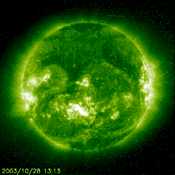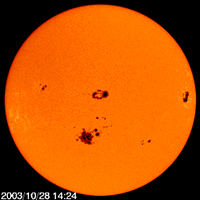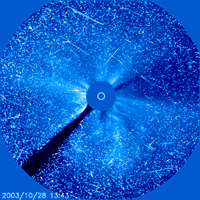A very active solar region with a complex sunspot pattern erupted this (EST) morning. The flare was registered by the GOES12 satellite at the X17 level, making it an S4 on the SEC's Space Weather scale. The active region was positioned perfectly near the Sun's central meridian at the time of eruption. The position of the region on the face of the Sun means that any material ejected, a CME, is likely coming right at the Earth.
The material ejected is part of the Sun's corona and is really a giant cloud of magnetized plasma; plasma is the 'fourth state' of matter (solid, liquid, gas, plasma) and consists of ions. The plasma acts like a giant liquid magnet, with truly awesome power. When this giant magnetic cloud interacts with the Earth's magnetic field, several side effects can be witnessed. If the magnetic orientation of the cloud is the opposite of the Earth's own magnetic field, then severe impacts on the surface of the Earth can be felt.
This flare is one of the largest of the current solar cycle, and past events of this magnitude have resulted in severe geomagnetic activity. Even though the D-region absorption from the x-rays is mostly over after the flare is over, the protons and electrons emitted by the eruption are causing the polar regions to absorb radio waves. The SEC has issued an A-index greater than 100 warning, meaning they expect severe geomagnetic storming from this event. It is interesting to note that this flare was rated at the maximum levels for both visual area and brightness, rating: 4B.
Addenda: Only a few days after the X17 flare erupted, the same active region produced an X10 flare with associated halo CME. The result of these flares was a severe period of storming for a couple of days. Bright Aurora were seen in Portland, even over the city lights. Aurora could be seen to the North, with rays and curtains being the predominant modes of presentation.
|
Images of the October 28, 2003 X17.2 Solar Flare
(note: the images are not chronologically aligned) |
||
|
Extreme UV (195nm) Image
Animation Of Solar Flare |
MDI Continuum Image Animation
Showing Sunspots |
SOHO C3 Coronagraph Animation
Showing CME |
 |
 |
 |
| (images courtesy NASA/SOHO) (animation by Max Riseman) |
(images courtesy NASA/SOHO) (animation by Max Riseman) |
(images courtesy NASA/SOHO) (animation by Max Riseman) |
| This image loop shows the X17.2 X-ray flare occuring near the middle of the solar disk. The CCD's pixels become overwhelmed by the intensity of the flare, causing their voltage to leak to neighboring pixels, resulting in the 'diamond' of light coming from the flare site. |
Region # 486 is the large region on the Southern portion of the solar disk. Region #10486 is the largest sunspot of the current solar cycle. |
The C3 Coronagraph shows the inbound CME that the X17.2 flare on October 28, 2003 produced. This CME had a perdominantly (+) Bz, making in not very efficient at producing a geomagnetic storm. The X10.0 flare had a (-) Bz on impact, thus producing widespread aurora. |
Summary of Very Active Solar Period
|
X-Ray Flare Class
|
Location Of (H-Alpha) Flare
|
H-Alpha Importance
|
Flare Type
|
Region
|
Duration
(x-ray) |
Start Date/Time
(UTC) |
|
X1.1
|
N08E58
|
1N
|
PRB
|
484
|
35 min
|
10/19/03 16:29
|
|
X5.4
|
S21E88
|
1B
|
BPT
|
486
|
30 min
|
10/23/03 08:19
|
|
X1.1
|
S17E84
|
1N
|
ERU
|
486
|
24 min
|
10/23/03 19:50
|
|
X1.2
|
S15E44
|
3B
|
?
|
486
|
96 min
|
10/26/03 05:57
|
|
X1.2
|
N02W38
|
1N
|
ERU
|
486
|
120 min
|
10/26/03 17:21
|
|
X17.2
|
S16E08
|
4B
|
PRB
|
486
|
93 min
|
10/28/03 09:51
|
|
X10.0
|
S15W02
|
2B
|
UMB
|
486
|
24 min
|
10/29/03 20:37
|
|
X8.3
|
S14W56
|
2B
|
UMB
|
486
|
33 min
|
11/02/03 17:06
|
|
X2.7
|
N10W77
|
2B
|
ERU
|
488
|
35 min
|
11/03/03 01:09
|
|
X3.9
|
N08W77
|
2F
|
ERU
|
488
|
36 min
|
11/03/03 09:43
|
|
X28*
|
S19W83
|
3B
|
UMB
|
486
|
37 min
|
11/04/03 19:29
|
* largest ever recorded up to this point
ERU = Multiple Eruptive Centers UMB = (>= 20%) Umbral Coverage BPT = One or More Brilliant Points |
|
S = <= 2.0 square degrees 1 = 2.1 to 5.1 square degrees 2 = 5.2 to 12.4 square degrees 3 = 12.5 to 24.7 square degrees 4 = > 24.8 square degrees |
|
|
Intensity of Flare: |
|
|
|
| This is the location of the flare as observed at the H-alpha wavelength. E refers to the Eastern, or 'new', region of the solar disk. W refers to Western, or limb. The limb is the location that represents the horizon of toward or away from Earth. N and S refer to North and South hemispheres of the Sun, respectively.. |
|
Space Weather Alerts Issued By The SEC
(during the active period) |
|---|
|
SPACE WEATHER ADVISORY BULLETIN #03- 5 **** EXTREME SOLAR FLARE **** Powerful Active Region 486 has produced one of the most intense solar flares ever measured. The event began at 12:29 P.M. MST (1929 UTC) on November 4th and rose quickly to exceed X17 on the GOES-12 X-ray sensor. By 12:44 P.M. MST (1944 UTC), the GOES sensor was saturated and remained that way until 12:56 P.M. (1956 UTC), suggesting this event extended well in to the very highest flare category, the X20 plus range. This massive flare produced a category R5 (extreme) radio blackout. All short-wave communications through the sunlit hemisphere of the Earth experienced complete blackout conditions. A powerful, and extremely fast (over 5 million miles per hour) mass ejection occurred from this flare site, but is mostly directed away from Earth. As a result, only category G1 (minor) to G2 (moderate) geomagnetic storm levels are likely on November 6th. This solar flare was the largest in a series of very large flares that have occurred in Active Region 486 over the past two weeks. At its peak, this sunspot cluster was approximately 15 times larger than Earth. This active region will rotate to the backside of the sun over the next 24 hours. Another large flare is still possible from this region, but large flare activity will become much less likely after the next 24 to 48 hours. |
|
**** MAJOR SOLAR AND GEOMAGNETIC ACTIVITY CONTINUES **** The intense solar flare (category R4 radio blackout - severe) that occurred on October 28th at 1110 UTC (6:10 A.M. EST) and its associated coronal mass ejection (CME) produced a category G5 (extreme) geomagnetic storm starting at 0613 UTC (1:13 A.M. EST) on October 29th. This geomagnetic storm lasted for twenty-four hours and produced category G3 (strong) through category G5 (extreme) conditions. This intense activity is occurring unusually late in this solar cycle, it has also produced the second largest solar flare and solar radiation storm of the cycle. The primary source of this activity, NOAA Active Region 486, has become the largest sunspot region observed during this cycle. |
|
SPACE WEATHER ADVISORY BULLETIN #03- 3 **** SOLAR ACTIVE REGION PRODUCES INTENSE SOLAR FLARE **** The dynamic solar regions reported on 21 October continue to produce high levels of solar activity. NOAA Region 486 produced a category R4 (severe) radio blackout with an associated category S3 (strong) solar radiation storm on 28 October at 1110 UTC (6:10 A.M. EST). The SOHO/LASCO instruments also observed a full halo coronal mass ejection with this activity, which is Earth directed. This region is the second largest in size this solar cycle. Further major eruptions are possible from these active regions as they rotate across the face of the sun over the next few days. Agencies impacted by solar flare radio blackouts, geomagnetic storms, and solar radiation storms may experience disruptions through this period. These include spacecraft operations, electric power systems, HF communications, and navigation systems. |
| SPACE WEATHER ADVISORY BULLETIN #03- 2 2003 October 21 at 06:11 p.m. MDT (2003 October 22 0011 UTC) **** INTENSE ACTIVE REGIONS EMERGE ON SUN **** Two very dynamic centers of activity have emerged on the sun. NOAA Region 484 developed rapidly over the past three days and is now one of the largest sunspot clusters to emerge during Solar Cycle 23, approximately 10 times larger than Earth. This region, which is nearing the center of the solar disk, already produced a major flare (category R3 Radio Blackout on the NOAA Space Weather Scales) on 19 October at 1650 UTC. The region continues to grow, and additional substantial flare activity is likely. Further major eruptions are possible from these active regions as they rotate across the face of the sun over the next two weeks. Agencies impacted by solar flare radio blackouts, geomagnetic storms, and solar radiation storms may experience disruptions over this two-week period. These include satellite and other spacecraft operations, power systems, HF communications, and navigation systems. |


